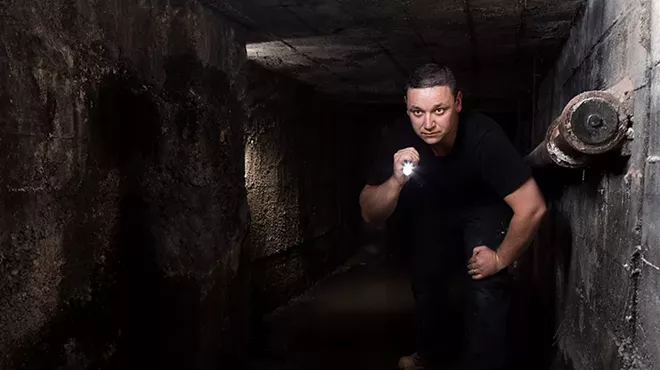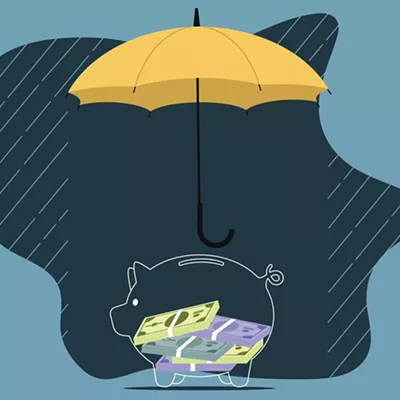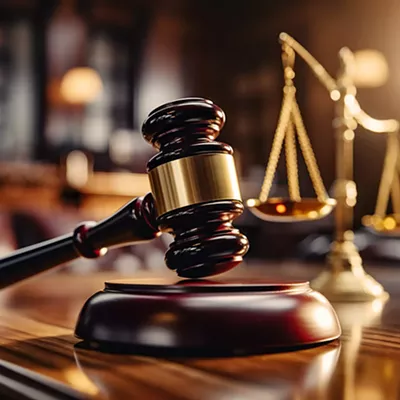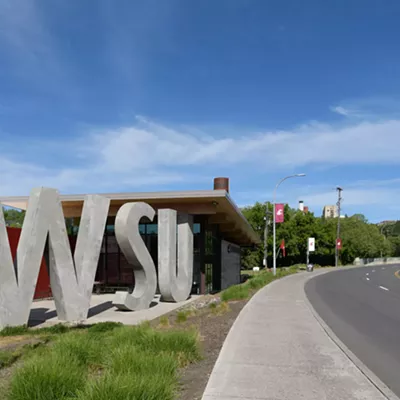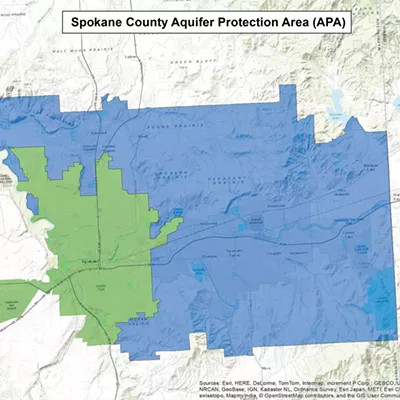Have you ever considered what lies beneath your feet? Ever stopped on a busy downtown Spokane street to have a look at those squares of colored glass set into the sidewalk? Have you ever slowed down to check out an old, deserted building and wondered at the life it once contained? Have you ever seen utility workers disappear down a manhole and speculated on what those sub-street catacombs looked like? We are surrounded by places unknown and stories untold. We're usually just too distracted by the immediacy of our daily lives to notice such shadowy things. But there they are.
It's impossible to live in Spokane for very long and not hear the tales of this city's wild and woolly past. Tales of speakeasies, opium dens, brothels and the accompanying police complicity are woven into the very fabric of this place. At the turn of the 20th century, downtown Spokane supported a huge transient population of Silver Valley miners, shuttled into town via the rail lines for recreation and relaxation. The area between what is now Spokane Falls Boulevard (then Front Street) and Main from Division to Howard was then lined with establishments -- hotels, taverns, gambling halls and brothels -- catering to the whims of lonely, hard-working men with a month's pay in their pockets and time to kill.
This story was inspired by such a tale -- specifically, that of a rumored tunnel system under the streets of downtown Spokane. The way I heard it, the system was initially constructed to carry steam heat from the Steam Plant to various downtown buildings. But it was also used for decidedly more illicit activities such as transporting liquor between outlawed drinking establishments during Prohibition. Was it only a romanticized urban legend? Did such a system even exist?
At first I thought that all I'd have to do is make a few phone calls, visit a couple basements and I'd be on a Jules Verne-esque journey to the center of, well, something. What I immediately discovered was that the very people best positioned to shine light on the existence of such a system were, oddly, the most tight-lipped on the subject. It became obvious that to get the answers I was after, I was going to have to get my hands dirty and, quite possibly, my feet wet.
And so, feeling a little uncomfortably like Geraldo Rivera looking for Al Capone's secret vault, I descended into the cobwebbed-filled darkness of a hidden world -- a forgotten world where the echoes of people conducting naughty business can still be heard over the sounds of dripping water, scurrying varmints and rattling ventilation units.
A quick initial tour of some of Spokane's most infamous basements yielded some tantalizing bits, though nothing definitive. Under the Coeur d'Alene Hotel (now home to O'Doherty's and Boo Radley's), one of the city's oldest buildings, are the remnants of an '80s comedy club -- 1980s, that is. Before that, however, it was a speakeasy, men's club and god knows what else. The basement of the Montvale Building across from the Fox Theater has sections of its concrete foundation along First Street interspersed with what appears to be very tunnel-like apertures sealed up with red brick. A trap door in the floor of Whats for Lunch on Howard leads to a labyrinthine passage that takes you directly under the sidewalk along Sprague. Curious. But no connections.
"There used to be tunnels under the buildings, and when they tear them down from time to time, you can see where they were," says local historian John Fahey. "They were utility tunnels. You could have probably ducked into a tunnel and crossed the street if you knew where you were going."
He laughs at the suggestion the tunnels were used to run booze.
"It was easier to pay the cop on the beat," he explains. "They were very practical. But I'm not surprised you're finding secret rooms and speakeasies. What would be surprising is if you hadn't found any."
Engineer Don Grove has been with the Spokane Club for nearly 20 years, and he's as familiar with the stories as he is with just about every square inch of this Kirtland Cutter-designed structure. The Spokane Club was on city steam for years, and Grove showed me the lines coming in from under Riverside. Alas, no tunnels. But there was something else.
"There is a room where they used to hide 50-gallon drums of whiskey in wooden barrels," he says. "They cut a hole right through the foundation."
Grove leads me to the women's lounge where -- without hesitation -- he peels back a line of lockers to reveal a section of wainscot with a small, square door cut into it. It's been screwed shut. He whips out his trusty Makita and soon we're looking at a hole in the concrete just big enough for someone to crawl through. Or to roll a whiskey barrel through. It passes into a dirt crawl space (with enough headroom for me to stand) two stories below street level. Grove has a stack of barrel parts in his shop, the remnants of wooden liquor barrels dating back to Prohibition times that were recently removed from the space.
"They had gambling on this floor, too," he says. "With slot machines. There's an area upstairs with a cashier's cage and a walk-in safe. There was a bar in the back. This whole floor was all open."
As for the tunnel system, Grove has some first-hand knowledge. "I understand that through the alleys there are tunnels underneath lined with cedar that they used to pump steam through to different buildings throughout the city. When I went to boiler school, they took us on a tour down there, and they had cast lines running through the tunnels and you could walk through them. Downtown is honeycombed with them."
So was it ever possible to start at the steam plant and walk through the entire system? "Probably so."
The basement of Dutch's Pawn Shop on Main is of interest mainly for the beautiful murals that adorn the walls, doors and just about every paintable surface (similar murals don the basement walls under 4 Seasons Coffee on Howard). Painted by artist Luke Williams in 1939, the murals themselves post-date Prohibition.
"There was more here before we did our remodeling," admits owner Gary Singer. The painted doors have since been used to construct shelving, and many of the murals are either obscured by piles of pawned goods or have been destroyed to create better access through the basement.
"This whole basement area was a speakeasy at one time," continues Singer "Above us was a transient hotel. When the railroads were big, guys would live here after a day's worth of work. They used to have poker games down here. As for the tunnels, you know, I've heard these stories about them, but I've never seen one. I don't know if maybe they exist only in people's imaginations."
But many legends are factually based, right? And there are those who have entered the tunnel system -- and have lived to tell about it.
The Fort Spokane Brewery is part of a very old block in downtown Spokane that has its own rather colorful history. The basement of the brewery used to house a speakeasy. In the alley is a manhole cover that Fort Spokane brewer Jeb Wilson claims is one access point to the tunnel system.
"I've been through the steam tunnels quite a few times. You could get into it through here until they repaved. We used to get into the Steam Plant through another one. And there are lots more. It's really patchy, though. You'll have a long section, and then it'll run into a wall because of the new construction downtown. "
Another portion of the system, he claims, was accessible from the hillside next to the Monroe Street Bridge, in front of the new library (a subsequent search of the area turned up nothing).
"That was opened until about three of four years ago, right down over the hill by Washington Water Power. You could just walk right into it. But it's blocked up now. They blocked off a lot of the tunnels."
Engineer Richard Polland of the Davenport Hotel says the utility companies actively discourage tunnel exploration.
"When I was getting my electrical degree, they told us about the tunnels under the streets down here. A few years back, they filled them with circuitry. A lot of the buildings downtown are hooked into it. And that's one reason Avista doesn't want people to know about these things."
The Davenport Hotel is the epitome of Spokane's "Age of Elegance," when wealth from the region's surrounding silver and gold mines flooded into the city. The Davenport is also full of secrets. From Louis Davenport's vault (still containing the opened safe), which lies under the sidewalk along Post Street to the clandestine "men's club," a trip through the Davenport's "down under" is an eye-opening experience. Polland, who has been engineer at the Davenport for the last seven years, leads me on a journey through time.
The marble steps leading down to the old Early Bird Lounge, a once-famous nightclub in the Davenport's basement, are noticeably worn from years of heavy foot traffic, testifying to the lounge's past popularity. "At one time, this was a speakeasy," says Polland of the formerly opulent drinking establishment. Across from the glass and neon swankiness of the Early Bird is a door leading into yet another lounge.
"This was the men's club," says Polland. "You can just imagine what probably went on back here."
From the fabulously appointed bar straight out of Rat Pack heaven to the card rooms and the cashier's booth complete with safe, coin trays and chip holders to the small, apartment-like rooms of unknown function, this was clearly a place designed to indulge the vices of wealthy men.
But Polland knows of the tunnels, and so we go deeper still. In the sub-basement (two floors below street level), there is a rusty steel door leading into a passageway another eight feet down.
"This used to be part of a tunnel system that went all the way down to the river," claims Polland. "Around that corner, it goes about 50 feet and then it's sealed off with cinder blocks."
This smelled like paydirt to me. The fact that the tunnel contained six inches of fetid, multi-viscosity liquid vaguely resembling water was mildly daunting. I returned a week later with a flashlight and a pair of PVC boots. Polland was off that day.
The tunnel (roughly five feet square) runs about 30 feet before opening up into a much larger space. It seems to be a portion of the hotel's ancient ventilation system and terminates at what appears to be part of the Sprague Street foundation wall. Is this the sealed-off portion of the tunnel system Polland spoke of? When I called the hotel later to talk with Polland, I was informed that he had "sought employment elsewhere." Once again, my search was turning up far more questions than answers.
My search ended where it probably should have begun -- at the Steam Plant. But the Wells and Company representative I talked to, though confirming the existence of a tunnel running 200 feet through the alley behind the Steam Plant and disappearing somewhere under Lincoln Street, would not grant me access due to safety and liability concerns.
With the aforementioned Rivera-Capone debacle again rearing its ugly head, I began to panic a little. The deeper I probed, the more I discovered. But each discovery sent me shooting off in another direction, diluting my prime directive.
As of today, the tunnels remain elusive. For all my searching, slogging around in muck and consumption of company time, I have yet to set foot in -- or even see with my own eyes -- the smallest fragment of a structure that is unquestionably a part of the famed tunnel system of Spokane. What I have seen are sections of stone and concrete foundations sealed with red brick and cinder block -- sections exactly where I would expect a tunnel opening to be. I also have confirmation of the tunnels' existence from a local historian and from men who claim to have personally navigated the system. In addition to the tunnel lore, I've discovered the remnants of a once lively and colorful subterranean culture, the habitat of Spokane's underworld.
So I'm calling off the search. I mean, I am operating under the concept of "deadline" here, and my editor is simply not going to wait forever to see something coherent come from all this. So for now I'm shelving my tire iron, flashlight and PVC boots and chaining myself to the computer in an effort to provide you with something resembling a good read. But if you've got a fresh lead for me to follow, I'll be back.
Share any tunnel lore you may have heard with Mike Corrigan at mike@inlander.com.



